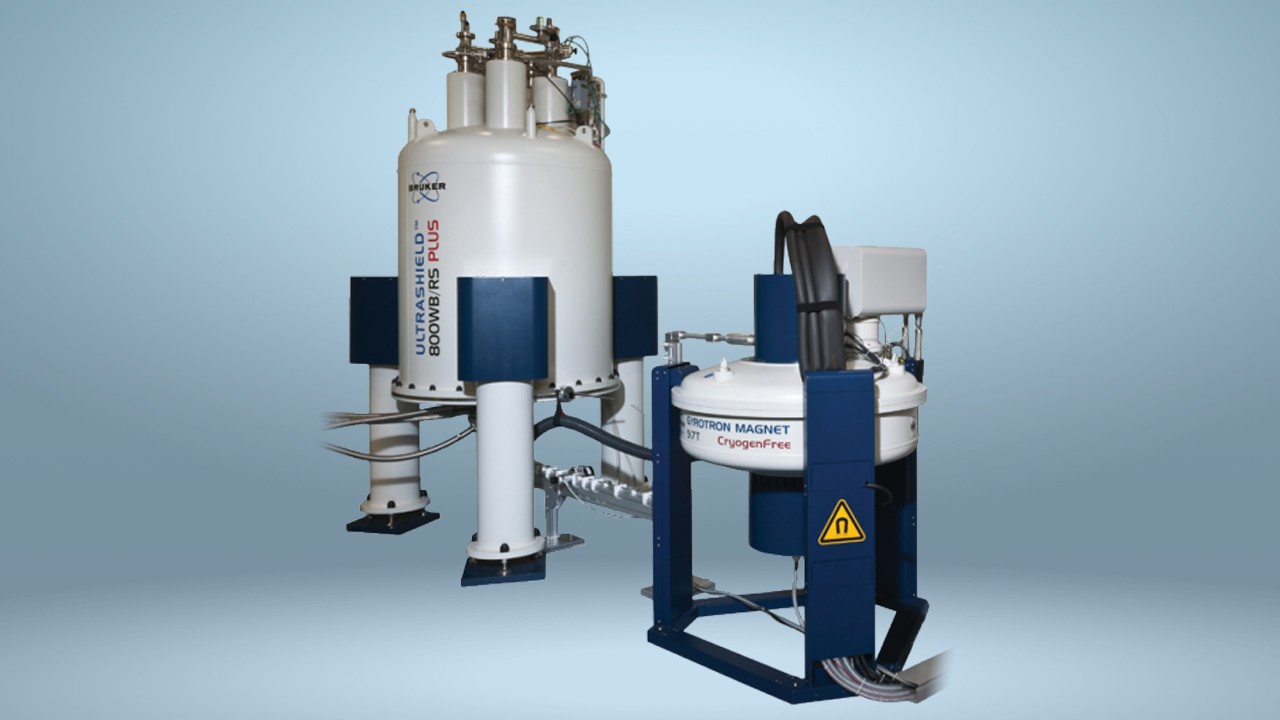Biological and Small Molecule Applications of DNP-NMR
Nuclear magnetic resonance (NMR) imaging, despite its ability to provide clear observation of structural components in solid-state compounds, has its limitations. The use of dynamic nuclear polarization (DNP) is quickly becoming an important adjunct in studies to help enhance spectroscopy sensitivities inherent in NMR.
In solid-state NMR spectroscopy, DNP facilitates a broader signal intensity over a large range of frequency, allowing for further insight into the anatomical structure of biological and small molecule compounds.
DNP has a wide range of applications, including studying the biological structure of proteins, membrane proteins, and fibrils. Another common application of solid-state DNP NMR is for small organic molecules, an application particularly useful for the pharmaceutical industry. Materials such as nanoparticles, catalysts, bio-materials, functionalized silica, mesoporous samples, and natural and synthetic polymers are also studied using DNP-NMR spectroscopy.
DNP-NMR applications for biological samples
DNP-NMR is used to study and characterize channel proteins, including KcsA potassium channel and M2 proton channel. Specifically, it can be used to characterize structural biology in environments with high complexity.
Other applications include the following:
• Amyloid fibrils
• Membrane proteins: Bacteriorhodopsin, Photorhodopsin
• Peptides: Vaccines, Self-assembled peptides
• Cell walls: Bacteria, Plants
Researchers may need to study and identify the anatomical structure of protein fibrils using solid-state NMR. To assist in improving the sensitivity of NMR, DNP can be employed in this situation. DNP can also enhance the study of cell wall polymers contained in intact cells, like bacterial cells.
In one study, researchers used DNP-enhanced NMR with a Bruker spectrometer to examine the intrastrand structure of amyloid fibrils. The conclusion was that DNP enhancement created an additional factor of three in terms of Boltzmann polarization while improving detection of intermolecular correlations and exerting no significant weakening of spectral resolution.
Another study used DNP to enhance NMR for the study of static samples of biological membranes. Compared to room temperature samples, the application of DNP saw a 40-fold enhancement in NMR, subsequently resulting in a 1600-fold time saving when compared to NMR without DNP.
DNP and small organic molecules
A newly developing field of DNP application is in the characterization of pharmaceutical compounds. DNP-NMR spectrometers can assist researchers in quickly distinguishing components of drug formulations, potentially helping to improve the speed of drug development and delivery without compromising safety or efficacy.
For commercial pharmaceutical formulations, DNP can also provide a swift and accurate data collection of 2D 1H-15N correlation spectra and can probe interactions between the drug matrix and drug molecule.
The Bruker DNP-NMR spectrometer has been used extensively in analyzing pharmaceutical compounds. At 9.4 T, DNP enhancement of solid-state NMR spectroscopy using a Bruker spectrometer is especially helpful for providing detailed characterization of pharmaceutical formulations at the anatomic level.
Pharmaceutical tablets are generally pulverized and injected with biradical polarizing agents in an effort to prevent the experiment from significantly altering the formulation. DNP experimentation allows for rapid collection with isotopic abundances of both one- and two-dimensional solid-state NMR spectra of the pharmaceuticals.
DNP-NMR spectrometer by Bruker
Bruker’s spectrometer is designed to enhance sensitivities in solid-state NMR experiments while allowing for shorter signal duration and longer experimentation. They transfer polarization via high-power gyrotron systems, enhancing signals from 20 to a factor of 200 by microwave irradiation at 263 GHz, 395 GHz, and 527 GHz.
The systems can be used for the study of a wide range of biological materials and small molecules, assisting in the observation of intricate compounds in the pharmaceutical, biological, and material sciences.
References
- Rossini AJ, Widdifield CM, Zagdoun A, et al. Dynamic nuclear polarization enhanced NMR spectroscopy for pharmaceutical formulations. J Am Chem Soc. 2014;136(6):2324-2334.
- Akbey Ü, Oschkinat H. Structural biology applications of solid state MAS DNP NMR. J Magn Reson. 2016 Aug;269:213-224.
- Bayro MJ, Debelouchina GT, Eddy MT, et al. Intermolecular structure determination of amyloid fibrils with magic-angle spinning and dynamic nuclear polarization NMR. J Am Chem Soc. 2011;133(35):13967-13974.
- Salnikov ES, Aisenbrey C, Aussenac F, et al. Membrane topologies of the PGLa antimicrobial peptide and a transmembrane anchor sequence by Dynamic Nuclear Polarization/solid-state NMR spectroscopy. Sci Rep. 2016;6:20895.


